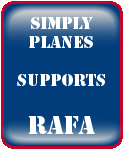Bristol F.2 Fighter
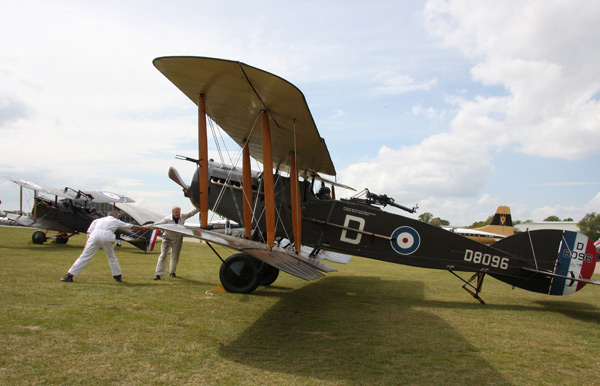
Bristol F.2B Fighter G-AEPH/D8096/D at Duxford Spring Air Show 2010. Photo by Bob Franklin
The Bristol F.2 Fighter was a British made two-seat biplane fighter and reconnaissance aircraft of the First World War. It was manufactured by The British and Colonial Aeroplane Company (Bristol) and designed by Frank Barnwell. It was mainly used by the Royal Flying Corps and also used by the Polish Air Force. The first flight of the Bristol F.2 Fighter was on 9th September 1916 with 5329 built. The aircraft is usually known as the Bristol Fighter, sometimes known by the nickname Brisfit or Biff. The F.2B two-seat variant of the Bristol Fighter proved to be a worthy adversary against the single-seat fighter aircraft of the opposition.
Frank Barnwell's idea for the design of the Bristol F.2 Fighter came from the need for a fighter aircraft in the same class as the Royal Aircraft Factory R.E.8 and the Armstrong Whitworth F.K.8. The engine to be used in the Bristol F.2 Fighter was a 190 hp (142 kW) Rolls-Royce Falcon I inline engine. The Type 12 F.2A version was armed with one synchronised fixed, forward-firing .303 in (7.7 mm) Vickers machine gun and one flexible .303 in (7.7 mm) Lewis Gun. In total 52 Bristol F.2A Fighters were built.
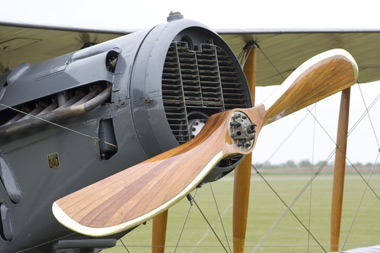
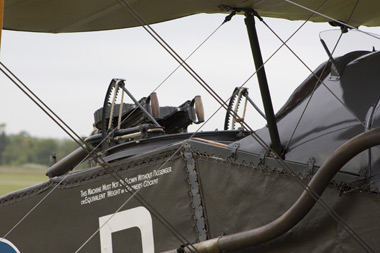
Bristol F.2B Fighter G-AEPH/D8096/D wooden propeller
Bristol F.2B Fighter G-AEPH/D8096/D machine gun
Images courtesy of Ross Cannon
Next came the definitive model, the Bristol Type 14 F.2B Fighter. The first flight of the F.2B was on 25th October 1916. The first 150 F.2Bs built were powered by the Falcon I or Falcon II engine. The rest of the F.2B Fighters were installed with the 275 hp (205 kW) Falcon III engine. With this engine equipped the aircraft could reach speeds of up to 123 mph (198 km/h). This made the F.2B variant over 10 mph faster than the F.2A. The F.2B variant also usually had a second Lewis Gun added to the cockpit.
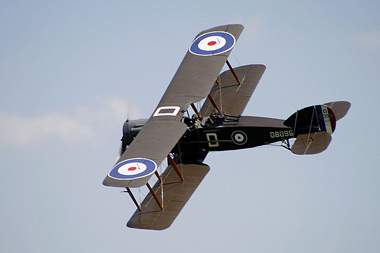
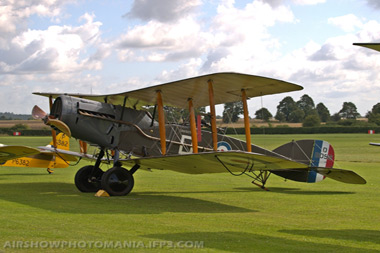
Bristol F.2B Fighter G-AEPH/D8096/D at Old Warden Air Show 2007
Bristol F.2B Fighter G-AEPH/D8096/D at Old Warden Air Show 2009
Images courtesy of Bob Franklin and Colin Sayce - Airshowphotomania.ifp3.com
An American version of the Bristol Fighter was planned to be designed and built by the United States Army Engineering Division. Their design of the aircraft incorporated a 400 hp (300 kW) Liberty L-12 engine, this engine proved to be too heavy and bulky and as a result made the aircraft nose heavy. 2000 aircraft were in the pipeline to be built, but only 27 were constructed.
After the war other variants of the Bristol Fighter were built. These included the Type 14 F.2B Mk II, this was a two-seat army cooperation biplane, this was fitted with desert equipment and a tropical cooling system. The F.2B Mk II first flew in December 1919, with 435 being built. Two other variants, a Type 96 Fighter Mk III and Type 96A Fighter Mk VI with improved structures were also built between 1926 and 1927. Fifty of these two variants were built in total. Some of the F.2Bs were modified for civilian use, using a Siddeley Puma engine and having cockpits enclosed by canopies, with a maximum speed of 128 mph (206 km/h). These were known as the Bristol Tourer.
Surviving Examples
As of 2007 there were three airworthy Bristol F.2 Fighters and various replicas.
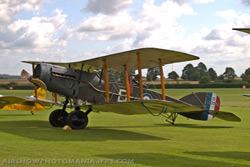
The Shuttleworth Collection owns an airworthy Bristol F.2 Fighter, Bristol F.2B Fighter G-AEPH/D8096/D. She is flown at various air shows including the Old Warden Air Shows. (Shown left - photo Colin Sayce - Airshowphotomania.ifp3.com)
The Canada Aviation Museum owns Bristol F2.B Fighter G-AANM/D-7889.
New Zealand film director Peter Jackson owns Bristol Fighter D-8040, the aircraft is flown from the Omaka Aviation Heritage Centre, who also own a second original fuselage.
RAF Museum Hendon houses a static display of an original Bristol F.2 Fighter.
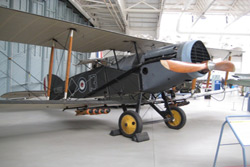
Bristol F.2B Fighter E.2581/13 is on display in The Battle of Britain hangar at the Imperial War Museum, Duxford in Cambridgeshire. (Shown left - photo Chris Cannon)
The Museo del Aire (Spain), Madrid in Spain, The VAF, Old Kingsbury in Texas and the Musee Royal de l'Armee, Brussels in Belgium also have Bristol Fighters on display.




